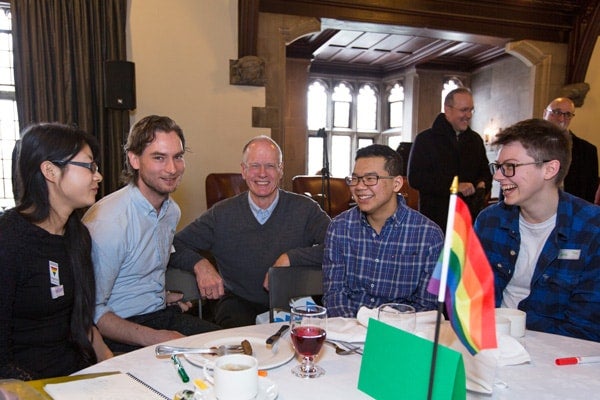
Thinking positive on equity and inclusion
Published: February 29, 2016
If you have not noticed any inverted triangles identifying a “Positive Space” on U of T campuses or elsewhere in the GTA, you must be a new arrival. Or possibly wearing very dark sunglasses.
“We always hoped that people would pick it up,” said David Rayside, the professor emeritus of political science who created the widely-distributed rainbow-coloured icon with his fellow activists in 1996. “We never imagined that as many would pick it up as did.”
The Positive Space Committee, as the informal U of T group has called itself, celebrated 20 years of positive engagement on LGBT and gender issues Monday in the Music Room of Hart House.
This two-hour event included a sit-down brunch, a panel discussion and a mix-and-mingle. There was also a video booth in which individuals or groups could go on the record with their thoughts on what Positive Space means to them.
The triangular sticker emerged along with the formation in 1996 of the committee, which met regularly in Room 240 of University College to discuss the state of tolerance and where improvement was necessary.
If not quite a no-brainer, the symbol seemed both obvious and irresistible.
“When the committee was formed, the rainbow flag had become quite widespread,” Rayside recalled. “And there was still some use of the inverted pink triangle as an iconic symbol. Basically, the group decided to combine the two.”
Rayside looked around to see if any other organizations had made a similar match. Seeing none, he started applying scissors to paper on his dining room table.
The slogan evolved from a rough poster that committee co-chair Rona Abramovitch, then status of women officer at U of T, pulled out of a briefcase.
“I forget where it came from, but it had no graphic appeal,” Rayside said. “And it had the words ‘Safe Space’ on it, which we thought were not quite the right angle for a university.”
The committee decided on the more upbeat “Positive Space” and the more compact triangular icon. “Affirmatively welcoming rather than defensively retreating,” is how Rayside sums up the message.
Initially taken up by groups and offices at U of T and then by labour unions, the symbol has spread to other universities and even other countries. Rayside says there is no way of estimating the number of Positive Space stickers out there.
“It began at U of T but we never sought any kind of ownership of it,” he said.
The sticker and slogan can mean different things to different people. Rayside, a former director the Mark S. Bonham Centre for Sexual Diversity Studies, thinks it ought to signify more than a grudging agreement not to discriminate.
“The question of course gets raised as to whether having sticker on your door or your computer means much in terms of commitment to inclusiveness,” he said. “But we never believed in policing that aspect of it.
“It was always meant as a small idea. It wasn’t meant as the leading edge of activism or advocacy around equity. It was supposed to be a different way of creating conversation at a time when creating conversation was an important part of the enterprise.”
There can be no denying the success of the Positive Space sticker. Still, Rayside cautions against equating that success with the end of difficulties for sexual minorities.
“Now the principal risk is that people assume that there aren’t any issues,” he said.
“This can happen in response to gender issues and a variety of equity causes. Complacency is a big issue.”



